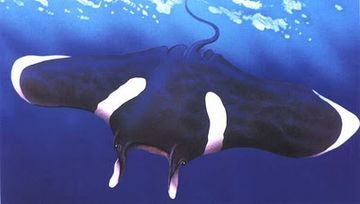Jackasslope - Cryptids & Co

More Posts from Jackasslope and Others

Beebe’s Manta Ray was first reported by William Beebe nearby the Galapagos Islands on April 27th, 1923. He described the manta as having a 10 foot wingspan. Its back is a dark brown with distinctive white bands that go halfway down its back to either side of its head. The very tips of the wings are also white in color. The manta supposedly collided with Beebe’s vessel briefly before quickly retreating from it.

Gef, sometimes referred to as the Talking Mongoose or the Dalby Spook, was a talking mongoose reported to inhabit a farmhouse known as Cashen’s Gap on the Isle of Man.
In September 1931, the Irving family, consisting of James, Margaret and 13 year old daughter Voirrey, heard scratching and rustling noises behind their farmhouse’s wooden wall panels. Initially they thought it was a rat, but then the unseen creature began making different sounds. At times it spat like a ferret, growled like a dog or gurgled like a baby.
The entity soon revealed an ability to speak and introduced itself as Gef, a mongoose. It claimed to have been born in New Delhi India, in 1852. According to Voirrey, the only person to see him properly, Gef was the size of a small rat with yellowish fur and a large bushy tail. (The Indian mongoose is in reality much larger than a rat and does not have a bushy tail). He would never allow anyone but Voirrey to see him, however, and if he didn’t like you, you could count on being insulted, or pelted with pebbles.
Many researchers suspected that Gef was a poltergeist, and the Irving’s daughter Voirrey was at the right age for that sort of thing. If a poltergeist, Gef was rather a nice one. He often talked and joked with the family, and would occasionally leave small game, mostly rabbits, on their doorstep for dinner.
Gef claimed at times to be “an extra extra clever mongoose”, an “Earthbound spirit” and “a ghost in the form of a mongoose”. He once said: “I am a freak. I have hands and I have feet, and if you saw me you’d faint, you’d be petrified, mummified, turned into stone or a pillar of salt!”
The only physical evidence cited in support of Gef’s existence would appear to be a series of footprints,none of which were identified as those of a mongoose, stains on the wall, supposed hair samples which were identified as having belonged to the Irving’s sheepdog, and several photos which were claimed by the Irvings to depict Gef, (such as the one above).
James Irving kept diaries about Gef between 1932 and 1935. These diaries, along with reports about the case, are in Harry Price’s archives in the Senate House Library, University of London.

Tasmanian wolf woven blanket design by MarcoNavarro on Threadless. I wish this had actually been made!

Kelpie
Creepy horses man, they creep me out just enough to want to paint them.





A selection of works from Artimalia’s 2017 thylacine tribute, 81 años sin Tilacino (81 years without thylacine).
Artists from left to right: Jaume Marco, Guiomar González, Jorge Ochagavía, Sol Álvarez and Amaya Oyón.

A newly discovered photograph of a captive thylacine at Beaumaris Zoo c.1913, found in a private collection in the U.K. by thylacine enthusiast Alan Pringle.
The photo was one of three purchased at Salamanca Market in Hobart over 20 years ago. [x]

Black Dogs -
An English ghost, a black dog can be seen as an omen of death and bad luck. They are often described as monstrously large with eyes of flaming red or green, appearing to those who are doomed to die. It is possible for them to have other demeanours though, some black dogs are benevolent and choose to watch over humans, even going as far as to walk women home at night and watch over children while they play. In some stories they are not so friendly, attacking and killing humans where they find them.
A notorious black dog from Suffolk was Black Shuck. This dog burst into a church during a service and killed a man and a boy who were attending church. The claw marks from the dog’s attack can be still seen in the church to this day.
Dartmoor is said to be home to many ghostly black dogs. They inspired the novel The Hound of the Baskervilles after Sir Arthur Conan Doyle spend some time there. The story of the hounds of Dartmoor tells of a huntsman who sold his soul to the devil. When he died he became a ghost that rides through the moors with a pack of black dogs running alongside him.
-
 cephalon-hq reblogged this · 4 months ago
cephalon-hq reblogged this · 4 months ago -
 eikonomachy liked this · 6 months ago
eikonomachy liked this · 6 months ago -
 harloqui reblogged this · 8 months ago
harloqui reblogged this · 8 months ago -
 sluttyonceler reblogged this · 10 months ago
sluttyonceler reblogged this · 10 months ago -
 soxry reblogged this · 10 months ago
soxry reblogged this · 10 months ago -
 johnmarston reblogged this · 10 months ago
johnmarston reblogged this · 10 months ago -
 legggatron reblogged this · 10 months ago
legggatron reblogged this · 10 months ago -
 pentheos reblogged this · 10 months ago
pentheos reblogged this · 10 months ago -
 rosemehdee liked this · 11 months ago
rosemehdee liked this · 11 months ago -
 riverdalians reblogged this · 11 months ago
riverdalians reblogged this · 11 months ago -
 riverdalians liked this · 11 months ago
riverdalians liked this · 11 months ago -
 iggyfing liked this · 11 months ago
iggyfing liked this · 11 months ago -
 dragonsbloodsnowcone reblogged this · 11 months ago
dragonsbloodsnowcone reblogged this · 11 months ago -
 skullfragments reblogged this · 11 months ago
skullfragments reblogged this · 11 months ago -
 teatimevibes reblogged this · 11 months ago
teatimevibes reblogged this · 11 months ago -
 jouglat liked this · 11 months ago
jouglat liked this · 11 months ago -
 sugarygrapefruit reblogged this · 11 months ago
sugarygrapefruit reblogged this · 11 months ago -
 killed-that-fucker liked this · 11 months ago
killed-that-fucker liked this · 11 months ago -
 peepeepoopoodumdum reblogged this · 11 months ago
peepeepoopoodumdum reblogged this · 11 months ago -
 peepeepoopoodumdum liked this · 11 months ago
peepeepoopoodumdum liked this · 11 months ago -
 edgykoalagod liked this · 11 months ago
edgykoalagod liked this · 11 months ago -
 tiredhermit reblogged this · 11 months ago
tiredhermit reblogged this · 11 months ago -
 tanukutie reblogged this · 11 months ago
tanukutie reblogged this · 11 months ago -
 tanukutie liked this · 11 months ago
tanukutie liked this · 11 months ago -
 samuelbeechworth liked this · 11 months ago
samuelbeechworth liked this · 11 months ago -
 frostlings liked this · 11 months ago
frostlings liked this · 11 months ago -
 blackenedsheep liked this · 11 months ago
blackenedsheep liked this · 11 months ago -
 i-twink-therefore-i-am liked this · 11 months ago
i-twink-therefore-i-am liked this · 11 months ago -
 sillyzone liked this · 11 months ago
sillyzone liked this · 11 months ago -
 secretmessages1983 reblogged this · 11 months ago
secretmessages1983 reblogged this · 11 months ago -
 kullotz reblogged this · 11 months ago
kullotz reblogged this · 11 months ago -
 psygull reblogged this · 11 months ago
psygull reblogged this · 11 months ago -
 synthetic-ultramarine liked this · 11 months ago
synthetic-ultramarine liked this · 11 months ago -
 svmbiotic liked this · 11 months ago
svmbiotic liked this · 11 months ago -
 davelleparallel reblogged this · 11 months ago
davelleparallel reblogged this · 11 months ago -
 davelleparallel liked this · 11 months ago
davelleparallel liked this · 11 months ago -
 electrificata reblogged this · 11 months ago
electrificata reblogged this · 11 months ago -
 missmassacre liked this · 11 months ago
missmassacre liked this · 11 months ago -
 retroactivebakeries reblogged this · 11 months ago
retroactivebakeries reblogged this · 11 months ago -
 doesnt-own-a-sportscoat reblogged this · 11 months ago
doesnt-own-a-sportscoat reblogged this · 11 months ago -
 reefsharkivist liked this · 1 year ago
reefsharkivist liked this · 1 year ago -
 awesomephd liked this · 1 year ago
awesomephd liked this · 1 year ago -
 fuckedwizard reblogged this · 1 year ago
fuckedwizard reblogged this · 1 year ago -
 worldonline liked this · 1 year ago
worldonline liked this · 1 year ago -
 fujoshimafia reblogged this · 1 year ago
fujoshimafia reblogged this · 1 year ago



